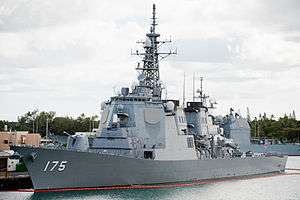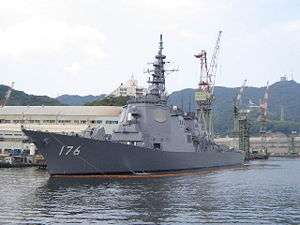Kongō-class destroyer
 Myōkō in 2012 | |
| Class overview | |
|---|---|
| Name: | Kongō class |
| Builders: | |
| Operators: |
|
| Preceded by: | Hatakaze class |
| Succeeded by: | Atago class |
| Built: | 1990 - 1998 |
| Completed: | 4 |
| Active: | 4 |
| General characteristics | |
| Type: | Guided missile destroyer |
| Displacement: |
|
| Length: | 528.2 ft (161.0 m) |
| Beam: | 68.9 ft (21.0 m) |
| Draft: | 20.3 ft (6.2 m) |
| Propulsion: |
|
| Speed: | 30 knots (56 km/h; 35 mph) |
| Range: | 4,500 nautical miles (8,300 km; 5,200 mi) at 20 knots (37 km/h; 23 mph) |
| Complement: | 300 |
| Armament: |
|
| Aircraft carried: | 1 × SH-60K helicopter |
| Aviation facilities: | Flight deck only |
The Kongō class (こんごう型護衛艦 Kongō-gata Goeikan) of guided missile destroyers serves as the core ship of the Japan Maritime Self-Defense Force (JMSDF)'s Escort Flotillas. Constructed in the 1990s, the Kongō class are equipped with the Aegis fire control system, being one of the few ship classes outside of the United States to have that capability.
Design
The Kongō class employs the highly advanced Aegis fire control system and is armed with the RIM-66 SM-2MR Block II surface-to-air missile, RUM-139 vertically launched anti-submarine rocket, the RGM-84 Harpoon anti-ship missile, two Mark 15 20 mm CIWS gun mounts, two torpedo mounts in a triple tube configuration, and an Oto Melara 127 mm (5 in)/54 caliber gun. Their Mark 41 vertical launch system can hold 90 missiles. However, in keeping with the defensive mission of the JMSDF and passive role of the Japan Self-Defense Forces in general, the Kongō class lacks the Tomahawk missile.
As on other ships employing the Aegis system, the superstructure is dominated by the SPY-1's phased arrays, which eliminates the need for a traditional rotating antenna. The design of the superstructure also incorporates certain stealth features, designed to reduce radar cross section of the ship; however, as a consequence, the ship is considerably more top-heavy than a typical destroyer and requires a much deeper draft. As such, operations in a littoral (coastal) environment are limited. Overall, Kongō-class destroyers are much larger than traditional destroyers and at 9,485 tons displacement come close to cruisers in size. Because they are built to different operational requirements than the Arleigh Burke-class ships, such as for carrying extra equipment for commanding a squadron, the Kongō-class ships' internal arrangement is quite different from the original design on which they are based. Recognisable external features are the vertical mast and the sleek sides of the bridge.
The Kongō-class vessels are being modified to serve in a theater missile defense role, with the primary intention of countering North Korean ballistic missiles. This purpose and a financial crisis made the Flight II variant of the Arleigh Burke class the choice for the follow-on class to the Tachikaze and Asakaze. The new destroyer class was named Atago in 2005.
Kongō-class destroyers are powered by four Ishikawajima-Harima LM2500 gas turbines.
In December 2007, Japan conducted a successful test of the SM-3 block IA against a ballistic missile aboard Kongō. This was the first time a Japanese ship was selected to launch the interceptor missile during a test of the Aegis Ballistic Missile Defense System. In previous tests they provided tracking and communications.[1][2] Afterward, Japan has also undertaken another two successful Ballistic Missile Defense test aboard Myōkō in October 2009[3] and aboard Kirishima in October 2010.[4] While one test aboard Chōkai in November 2008 failed to intercept the target.[5]
Namesakes
The Kongō-class destroyers are named after mountains in Japan, and all four also share their names with World War II era Japanese warships. Kongō and Kirishima share their names with two ships of the Kongō-class battlecruiser, while the two ships share their names with the heavy cruisers Myōkō and Chōkai.
Ships in the class
_refuels_the_Japan_Maritime_Self-Defens.jpg)
.jpg)

| Building no. | Pennant no. | Name | Laid down | Launched | Commissioned | Home port |
|---|---|---|---|---|---|---|
| 2313 | DDG-173 | Kongō | 8 May 1990 | 26 September 1991 | 25 March 1993 | Sasebo |
| 2314 | DDG-174 | Kirishima | 7 April 1992 | 19 August 1993 | 16 March 1995 | Yokosuka |
| 2315 | DDG-175 | Myōkō | 8 April 1993 | 5 October 1994 | 14 March 1996 | Maizuru |
| 2316 | DDG-176 | Chōkai | 29 May 1995 | 27 August 1996 | 20 March 1998 | Sasebo |
The Kongō class in popular culture
The Kongō class has been featured in several works of fiction. In the anime series Neon Genesis Evangelion, it appears in the eighth episode, when Evangelion Unit-02 is delivered from Germany to Japan (also seen is the Arleigh Burke class USS Ramage). In High School of the Dead, the Kongō's CIC intercepts three of nuclear warheads while the Arleigh Burke class USS Curtis Wilbur fails to shoot down the fourth due to an onboard outbreak.
The JMSDF allowed the producers of the Japanese movie 亡国のイージス ("Boukoku no Aegis") to shoot aboard Myōkō, which stood in as the film's Aegis destroyer, called the いそかぜ (Isokaze). The DDG-175 hull number was retained for the movie. The ship would later appear in the 2012 movie Battleship. In the Tom Clancy novel Debt of Honor, the fictional lead ship of the line, Mutsu, figured prominently in a Japanese plot to wrest the US Navy's control of the Western Pacific region.
The Ace Combat series of flight simulation video games used the Kongō class in several missions where the player faces naval forces. The game "Wargame: Red Dragon" depicts the Kongō-class destroyer as one of the ships available to NATO forces.
See also
References
- ↑ Agence France-Presse. Japan shoots down test missile in space: defence minister. Accessed December 23, 2007.
- ↑ MDA press release Archived April 11, 2008, at the Wayback Machine.. 17 December 2007.
- ↑ "Youtube".
- ↑ "Youtube".
- ↑ "Youtube".
External links
| Wikimedia Commons has media related to Kongou class destroyers. |
- GlobalSecurity.org; JMSDF DDG Kongo Class
- Japan Maritime Self-Defense Forces page on Andrew Toppan's Haze Gray and Underway web site